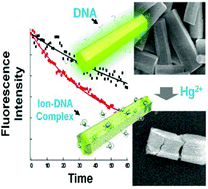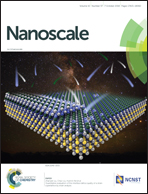Mercury ion–DNA specificity triggers a distinctive photoluminescence depression in organic semiconductor probes guided with a thymine-rich oligonucleotide sequence†
Abstract
DNA strands have been recently found to play a role in crystallizing organic semiconductors as a substitute for conventional surfactants. Such DNA-guided organic semiconductor particles possessed the recognition ability to complementary target DNAs, resulting in “enhanced luminescence” due to the lesser degree of non-radiative dissipation. Apart from this, in this study we developed selective recognition of mercury ions by utilizing DNA probes having ion-specific thymine-rich motifs. Strikingly, the specific ion–DNA interaction triggered rather distinctive “depressed luminescence” emitting from the particles. The mercury ions were found to be present both at the surface and the inner regions, which were discovered to relate to the drastic morphological distortion of the particles as evidenced by elemental, electron microscopy, and confocal fluorescence microscopy analyses. This novel phenomenon discovered would expand the technological values of organic semiconductors conjugated with oligonucleotides toward a wider range of target-specific applications.



 Please wait while we load your content...
Please wait while we load your content...